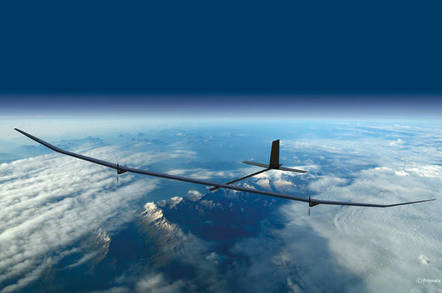BAE-backed Brit upstart makes eye-catching UAV claim
The Phasa-35 drone, under development by Hampshire-based firm Prismatic with the backing of BAE Systems, is intended to be a High Altitude Long Endurance (HALE) craft, again similar to the Airbus drone.
The craft is said to have a 35-metre wingspan and weigh 150kg, powered by electric motors fed from a lithium-ion battery. It is not yet a marketable thing, according to today’s BAE statement, though it is an interesting proposition nonetheless. Prismatic said the craft can be ordered from June with a 12-month delivery lead time.
The BAE claim of year-round aerial ability is eye-catching – particularly that it will use “only the sun to power the aircraft during the day and recharge the batteries for overnight operation”.
Prismatic’s own marketing spec sheet for the Phasa-35 revealed that it has a useful payload of 15kg and a max altitude of between 55,000ft and 70,000ft, which it said “provides high availability against prevailing winds”.
These are above the typical height for the jet stream, according to the Met Office, which puts their usual max heights as between 9 and 16km, or about 52,500ft in aviation-standard units. Jet stream winds can reach speeds of up to 200mph, which would drive any small, light aircraft well away from its target.

The 15kg payload on the spec sheet compares favourably with the Zephyr’s 5kg payload.
So far the MoD is trialling three of the Phasa-35’s competitor Airbus craft. Both are effectively flying solar panels capable of staying up for around 45 days at a time.
Flying high on juice from the Sun
The main use for unmanned aircraft that can fly for long periods of time without needing to land is surveillance. As the technology matures, military interest in unmanned aircraft for so-called “persistent surveillance” is growing. Aircraft such as the Phasa-35 and the Airbus Zephyr HAPS (high altitude pseudo-satellite) are attractive because they offer the ability to get “eyes on” a particular area for extended periods of time, provided the weather’s OK.
In simple terms, covering the flat surfaces of an electric, unmanned aeroplane with solar panels and then flying it high enough to keep clear of most earthly adverse weather offers possibilities for satellite-style operations without the vast cost of launching and maintaining an orbital bird.
Prismatic’s craft is offered for both military applications as well as “resource management and communications”, which ties it in neatly with a Facebook ambition dating back to 2016 for “thousands” of connectivity-providing craft orbiting the globe. ®





